
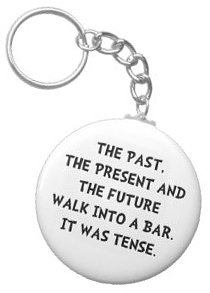 Introduction
Introduction
It might not look it, but this modest little English verb tenses mind map took me absolutely ages to do!
The reason is that there was a whole host of things to pay attention to: the design and layout of the map itself; choosing useful grammatical examples; finding appropriate images and modifying them.
Last but far from least, I had to research and basically reinvent the best, clearest, simplest, most consistent and accuratest way of representing all the tenses using a couple of coloured arrows and a dot. Phew! Mind mapping friends: see what you think; English grammar gurus… be kind!
JPG Image 800 px ~ JPG Image 1920 px ~ JPG Image 3500px
PDF Doc ~ Sab on Biggerplate!
Feel free to use my ‘English Verb Tenses – Ultimate Mind Map’ as follows:
1) For any NON-commercial use
2) Leave it EXACTLY as it is
3) Don’t change ANYTHING
4) Make sure the © Copyright text is included and intact
5) See 2) and 3) (you get the idea!)
You CAN reproduce it online or embed it in your blog or website as long as you…
6) Respect 1-5 above
7) Include a credit to ‘Sab Will / Mind Map Mad’ if posting in a primarily mind mapping context. Include a credit to ‘Sab Will / Fun English Lessons’ if posting in a primarily English learning context AND a clickable link to this page ( http://www.mindmapmad.com/2015/06/english-verb-tenses-ultimate-mind-map/ ) on the web page next to or near the image – thanks!
Anyway, it’s a place absolutely crammed with cool mind maps, including mine – he he! You can download the actual original iMindMap file (the mind mapping software I use) and play around with it yourself. Nice!
 Confidence and desire; understandable pronunciation; an opportunity to practise; a good vocabulary. These are some of the essential elements English students need if they are to progress and succeed as language learners and users.
Confidence and desire; understandable pronunciation; an opportunity to practise; a good vocabulary. These are some of the essential elements English students need if they are to progress and succeed as language learners and users.
Perhaps above all of this, though, like an all-encompassing, protective umbrella, floats grammar. Or perhaps it’s the equivalent of the bones of our body which support everything else.
Of course, you can communicate very well with little actual ‘language’. Miming, context and smiles can get you a fair way. But if you really want to use a language competently for professional or educational reasons, or even just holding a good conversation down the pub or over a meal, reasonable grammar is essential.
In offering you this English verb tenses mind map, I give you the basic knowledge of the English verb tenses I have shared with practically every English student I have ever taught over the last 20 years.
As I hinted earlier, this was not an easy undertaking. As an English teaching professional, I am basically putting my reputation on the line.
OK, so a list of the fundamental active English verb tenses with a handful of examples is hardly ground-breaking. In fact, it’s downright banal.
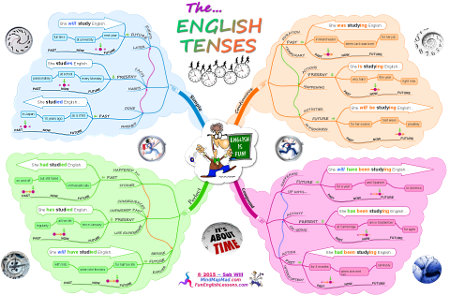 However, I’m trying to present this information in a way which is both useful and enjoyable; clear yet comprehensive; fundamental but fun.
However, I’m trying to present this information in a way which is both useful and enjoyable; clear yet comprehensive; fundamental but fun.
Not only that, but it was a test of my two key areas of supposed competence and the target of all my efforts: mind mapping and English language teaching. I have a lot to lose!
Funnily enough, probably the thing I’m most satisfied with is the little arrow-and-dot graphics sitting nicely on a branch-cum-timeline. In over 20 years of English teaching I’ve never really sat down and tried to create the ultimate system, which, by definition, has to be simple, clear and reasonably correct.
I say ‘reasonably’ correct because in the end it’s not an exact science. Also, for a given tense, there may be several different ways of looking at it and representing it graphically. The present perfect is a case in point.
So I’ve necessarily vastly over generalised in some instances in the name of not cluttering up the mind map. I’ll leave it up to you to point out and explain the limits of the tool.
This isn’t a grammar lesson, so I’m not going to send you to sleep with a long boring discourse on the relative merits of the past simple and the present perfect.
Instead I’ll send you to sleep with a little discussion about my timeline diagrams, in case they are, incredibly, not as clear as I’d like to think they are.
Here are the symbols I’ve used:
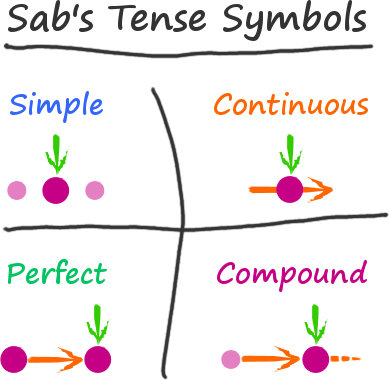
NOTE: I did a fair amount of research (Googled ‘timelines’) as well as checked all my dusty grammar books to try and find a fantastic, simple, elegant graphical representation of all the English tenses.
I didn’t find one. So this is my attempt to create one, here and now, just for you guys (I know, I know… I’m too good to you 😉 I tried to keep it to the absolute minimum number of symbols required, especially due to the space and time constraints I had. So I developed a system comprising only two basic elements: an arrow and a dot.
Note: I use the term continuous in this article. Some people prefer the word progressive. They are, effectively, the same thing.
![]()
The simple tenses are represented as a purple dot on a line, symbolising their ‘instant’ moment in time nature. The green arrow is to draw our attention to the point in time we are most interested in.
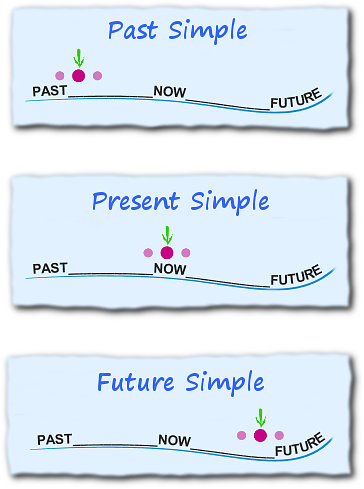 I almost left it at that, but in the end I decided to add a smaller, paler dot on either side of the big one to include the ‘habitual, repeating action’ function. Bam!
I almost left it at that, but in the end I decided to add a smaller, paler dot on either side of the big one to include the ‘habitual, repeating action’ function. Bam!
Another important goal I had was to use a single symbol for the past, present and future versions of the tense or aspect.
As I mentioned earlier, there are serious limitations to this approach. I think it is useful, nevertheless, to let people see the similarities between tenses within the same family. We can bowl them over (and often total confuse them) later with all the variations and subtleties that lie within.
In the past it shows a specific, finished event, such as a holiday (duration of the event is not shown).
It can also be used to represent repeating past actions, such as ‘I went to the cinema every Saturday morning’.
In the present its use is the same, with the big purple dot representing something that is true now (I live in Paris) and the series of dots indicating present habits: I go swimming with my son every Sunday afternoon.
In the future, we have something which will be true in the future, or a future habit: I will call you every week…
![]()
For this I used another extremely simple representation to show the idea of an event or action in progress at a given point in time. An orange horizontal arrow stands for the action, with the purple dot, highlighted by the green arrow, indicating the precise point in time we are focusing on.
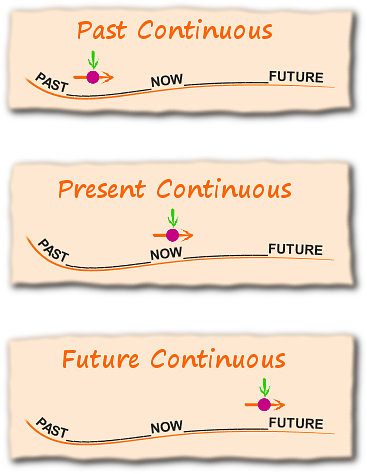 In the past, this means that something (the orange arrow) was happening before, during and even after another specific past event (without a time duration – the purple dot) occurred. I was watching television when the phone rang. Maybe I continued watching television after the phone stopped ringing, it’s perfectly possible.
In the past, this means that something (the orange arrow) was happening before, during and even after another specific past event (without a time duration – the purple dot) occurred. I was watching television when the phone rang. Maybe I continued watching television after the phone stopped ringing, it’s perfectly possible.
In the present, the action is happening as we speak, right now. It started sometime in the past and will finish sometime in the future.
For future uses, it’s something that will be going on, or in progress at some future point in time. For example, I’ll be working when you arrive, so I’ll see you when I finish.
So as not to complicate things, this diagram doesn’t show the idea of doing things around a point in time but not necessarily at that precise point in time. Such as ‘I’m taking salsa classes’, said conversationally whilst having dinner. Adding more dots to this very simple (and clear) diagram would only have confused things.
![]()
Now this is where things start to get interesting: I decided to use two dots at full intensity! My idea is to show that we are linking two points in time. Simple. Actually, when teaching this I use another diagram involving an ‘eye’ looking back from the right-most point to the one of the left with a dotted line, but I wanted to keep things uncluttered here. The green arrow is intended to represent the point we situate ourselves when looking back.
The thing all the perfect tenses share is this linking of two points in time. More precisely, there’s a sort of looking back in time from one point to an earlier point. This is often so see how long something has been going on or a certain state has been in existence, such as ‘How long have you known Sally?’ or ‘How long have you lived in France?’.
We often don’t mention both of the points explicitly. We say ‘I’ve lived here for almost ten years.’ as opposed to ‘I’ve lived here from the 13th September 2005 until today, the 29th August 2015.’
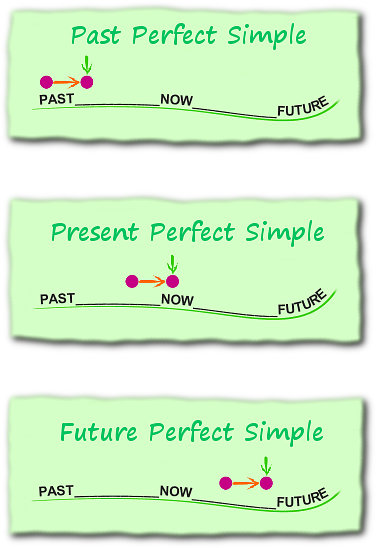 Again, I simplified. In contrast to what I call the compound tenses below (effectively the perfect continuous tenses), the perfect simple tenses don’t tend to focus so much on the duration of an event.
Again, I simplified. In contrast to what I call the compound tenses below (effectively the perfect continuous tenses), the perfect simple tenses don’t tend to focus so much on the duration of an event.
They are more about the fact that there are two significant points in time, one of which happened before the other.
Of course, we are often interested in the length of time between these points: ‘I have lived in Paris since 1993 / for 22 years.’ (see perfect continuous tenses section below for more details)
But frequently we are not: ‘I’ve never been to China.’ ‘Have you finished your homework yet?’ ‘Damn! I think I’ve lost my ticket.’
The past perfect simple links two points in time, both in the past. This tense tells us which event happened first. ‘I’d already finished the report when my boss got back.’
The present perfect simple links the present to a point earlier in time, in other words it links the present to the past. This tense is, of course, hugely important in English and is one of the most difficult for learners of other languages to master.
The future perfect simple is exactly the same in that it links two points in time. Here, we position ourselves at some point in the future, and, as usual, ‘look back’ to see how long something will have been true, or will have been the case, by this point. ‘I’ll have watered all the plants by the time you get back, don’t worry.’
One thing to note with the future perfect simple is that the second point, the one we look back to, can be earlier in the future, in the present, or even in the past relative to today. ‘
As a true example: Past Perfect: ‘In the year 2000 I had lived in France for 17 years.’; Present Perfect: ‘At the moment, as I write this in 2015, I have lived in France for 22 years.’; Future Perfect: When I’m 64 I will have lived in France for 36 years!’
![]()
Finally, the ones which make some students roll their eyes and pull out their hair: the dreaded perfect continuous tenses! They’re not that bad actually.
In fact, there is sometimes a direct correspondence between a form in the student’s own languages and English, especially if it’s a European one.
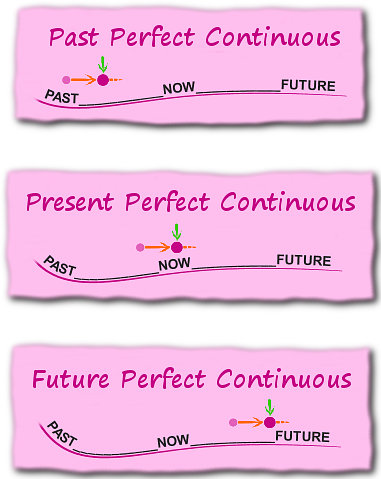 Anyway, the symbol I invented tries to combine the main characteristics of the perfect tenses and the continuous tenses, reminding us of the previous symbols, without being too overwhelming.
Anyway, the symbol I invented tries to combine the main characteristics of the perfect tenses and the continuous tenses, reminding us of the previous symbols, without being too overwhelming.
The perfect characteristic of linking two points in time is included, but the dot on the left is smaller and paler, indicating that this aspect is less important here.
Also, the orange arrow, indicating the activity in progress, stops at the dot indicated by the green arrow but potentially carries on after it, as shown by the dotted line to the right, without an arrow head. This refers to the fact that situations or on-going activities are not necessarily terminated by the event or point in time represented by the big purple dot and the green arrow. Phew, still with me? OK 😀
For the past tense version, it’s an activity that was in progress up until a point in the past: ‘I had been training for over a year when I won my first race.’
In the present perfect continuous, it’s usually for activities which have been going on up till now, and may still continue into the future: ‘Why are you hot? – I’ve been running.’; ‘She’s been cleaning the house all morning, and still hasn’t finished.’
The future perfect continuous form is one I like to wow my students with. ‘Does that really exist?’ they often ask me! Well, yes it does, and it’s not so complicated really, when you understand the others: ‘By the time we arrive, we’ll have been driving for two whole days!’
That did turn into a bit of a grammar rant after all, didn’t it? So, to sum up, the English tense system is both more extensive and yet more logical and ordered than many students are aware of.
Most learners, incredibly, have never seen all of the English tenses presented together like this before. Some of them will appreciate a linear presentation too, like this:
ENGLISH VERB TENSES
PRESENT
PAST
FUTURE
PRESENT PERFECT
PAST PERFECT
FUTURE PERFECT
SIMPLE
She works
She worked
She will work
She has worked
She had worked
She will have worked
CONTINUOUS
She is working
She was working
She will be working
She has been working
She had been working
She will have been working
It can be very useful to show them this, but can be a bit overwhelming for some. So I stress that ‘That’s all of them, now let’s concentrate on each tense, one tense at a time.’
I will often focus on the difference between two tenses, such as the past simple and the present perfect. This is useful, doable, and sometimes even liberating for your learners. And I don’t italicise lightly.. 😉
 Colour codes are extremely useful for students so they can see the shared elements, such as the ~ing endings of all the continuous tenses, clearly. Use mine, or use your own, but above all… use ’em! (I must admit, the blue is a very recent addition just because I can. On the board I generally use red for the orange items above, and green where it’s green… and that’s it – it works well 😀 )
Colour codes are extremely useful for students so they can see the shared elements, such as the ~ing endings of all the continuous tenses, clearly. Use mine, or use your own, but above all… use ’em! (I must admit, the blue is a very recent addition just because I can. On the board I generally use red for the orange items above, and green where it’s green… and that’s it – it works well 😀 )
I also often highlight the similar characteristics shared by, say, all the perfect simple tenses, or all the continuous tenses, for example. This gives students a ‘big picture’ overview which can also be helpful.
When all’s said and done, you’ve just got to give your students the best English learning experience possible. For me, that’s by exposing them to as many ways of ‘experiencing’ the language as possible.
The English Verb Tenses ‘Ultimate Mind Map’ is just one more weapon in your arsenal, if you’ll forgive the military metaphor. Now go fight them on the benches, and make sure to give some Fun English Lessons whilst doing so! 😀
2015 Sab Will / Mind Map Mad
 Mind Map Mad Facebook Group
Mind Map Mad Facebook Group
If you’d like to join our friendly mind map discussion group on Facebook to learn more about mind mapping and submit your own creations, then you’re welcome!
Just click the button below and join up straight away – I look forward to meeting you there 😀
Here are those download links again, and don’t forget to let me know what you think here. Did you find my English Very Tenses – Ultimate Mind Map useful, and how will you use it, either for yourself or your own students? Feel free to share, and I hope it helps you in some way!
JPG Image 800 px ~ JPG Image 1920 px ~ JPG Image 3500px
PDF Doc ~ Sab on Biggerplate!
Feel free to use my ‘Black and White Mind Map’ as follows:
1) For any NON-commercial use
2) Leave it EXACTLY as it is
3) Don’t change ANYTHING
4) Make sure the © Copyright… text is included and intact
5) See 2) and 3) (you get the idea!)
You CAN reproduce it online or embed it in your blog or website as long as you…
6) Respect 1-5 above
7) Include a credit to ‘Sab Will / Mind Map Mad’ AND a clickable link to http://www.mindmapmad.com on the web page next to or near the image – thanks!
Anyway, it’s a place absolutely crammed with cool mind maps, including mine – he he! You can download the actual original iMindMap file (the mind mapping software I use) and play around with it yourself. Nice!
I sourced some of the images for this FREE mind map through Google searches. It would have taken too much time, for dubious effects, to attempt to track down and credit the authors of all of these various excellent images.
However, as an original content creator myself, I totally and intrinsically respect the original artists’ rights. If any of the authors of any of these images see them and want a credit and link back to their work I’m only too happy to oblige. This English Verb Tenses – Ultimate Mind Map is not a commercial product and is available for free download on this web site and elsewhere. Please enjoy and share if you want to, thank you.
Leave a Reply
You must be logged in to post a comment.